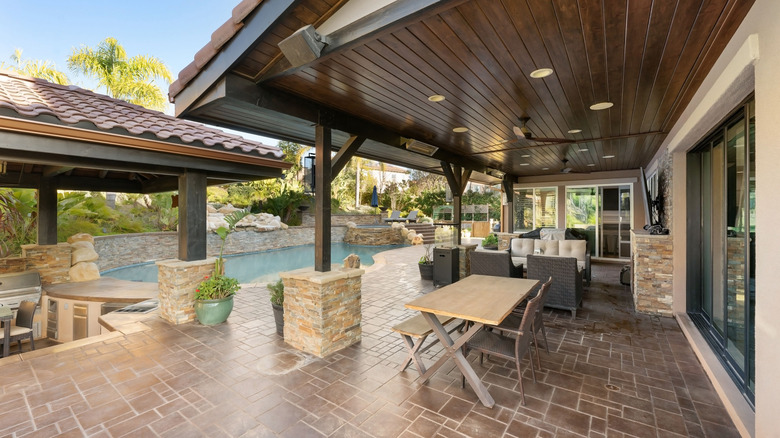Heated Patio Flooring: What To Know Before Installing
As the sun rises and birds begin to chirp, you step out onto your patio to enjoy a lovely autumn morning. While your hands might be warmed by your full coffee mug, your feet catch a chill from your patio, a shiver forcing you back inside. With heated patio flooring, you could enjoy the beautiful weather at any time in any season.
The idea of heated outdoor flooring fuels dreams of turning your patio into the ultimate outdoor entertaining destination, but what does it actually entail? Heated patio flooring utilizes radiant heat, which can be created with either hydronic or electric in-floor systems. These systems sound complicated, but they're more straightforward and customizable than you might think, and they're as easy to maintain as the patio floor you already have. You also have aesthetic options when it comes to the flooring, as radiant heat can be accomplished with materials including concrete, tile, pavers, and stone. Installing in-floor heating is also approachable for experienced DIYers, but there are plenty of available flooring professionals who can take care of the installation for you. Professional installation ensures there are no issues with the heating element — the integral part of your heated patio.
How in-floor radiant heating works
The heating of your patio is accomplished by electromagnetic radiation, which carries radiant heat from the in-floor element to your cold feet. These elements — either heating cables (electric) or water pipes (hydronic) — generate the electromagnetic radiation that is then absorbed by the things above the floor such as you, your guests, and your patio furniture, establishing a zone of warmth. Electric options are especially convenient, as they require no pumps or plumbing and can be fully automated, utilizing sensors to detect outside temperature.
With in-floor patio heating, you can create a cozy fall patio space perfect for entertaining, even in areas that see early snowfall. Some patio heating systems include snow melting elements that are customized to your needs and environment, enabling you to continue hosting barbecues and backyard get-togethers well into winter. Unfortunately, none of this can be installed beneath your existing patio. The elements must be laid during construction, so installing a floor heating system gives you a great opportunity to redesign your patio. Putting in a heated patio costs around $1,500 per every 100 square foot heated area, not including installation costs, and since the elements are powered by your house's electric system, the patio will be subject to the price of electricity in your area.
The benefits of heated patio flooring
Because of the benefits, many homeowners feel heated patio flooring is worth the cost. Heated patio flooring is just one of many backyard landscaping ideas that will transform your space, but it is perhaps the most significant, as it turns your patio into an all-season gathering place. This maximizes your patio investment, as you can get more enjoyment out of it throughout the year. In addition to increased entertainment opportunities, heated patio flooring is safer than unheated flooring, which can be hazardous in the winter.
Homeowners in cold, snowy areas might be used to spreading rock salt on their driveways and patios, accepting it as a necessary evil, but heated flooring makes the evil no longer necessary. On concrete surfaces, rock salt can cause spalling, or surface erosion. There are many ways to prevent spalling, but replacing your patio with a heated one gives you the most bang for your buck. Heated patios also decrease the risk of slipping and falling on hard patches of ice, some of which might appear invisible at first, so you can enjoy your patio in comfort and without fear.


